How to Use Custom Flags for Business Branding
In the digital age, it’s easy to neglect the possibilities of traditional advertising and marketing media. But just drive down any busy avenue or thoroughfare in America, and you’ll be sure to see the power of traditional media all around you: avenue banners, sale and promotion signs, company logo banners—even “OPEN” signs are a form of advertising. At Gettysburg Flag Works, we know that custom flags and banners can still carry the weight of some marketing campaigns. In fact, even though most companies’ digital presence is gaining steam, almost 20% of our business since 2008 has come from custom flags and banners. That means that a lot of businesses still recognize the value that custom business banners can bring to their marketing efforts.
Custom business banners can be a great investment, and one that will continue to perform for months or years to come. Benefits include:
- Brand exposure that’s visible 24 hours a day, 365 days a year
- A lower initial investment – the cost per thousand is much lower for signage than for any other type of advertising
- Versatility – The flag or banner becomes an asset that can be used for long periods of time or repurposed again and again
As with any type of marketing initiative, timing is key. So, as you think about ways to round out your marketing and promotion strategy, consider whether now is the time for custom flags or banners to be the right investment for your business.
One-time cost, continuing return on your investment
If you have a new business, or a brick-and-mortar location that is rebranding, refreshing or having a big event, you want all eyes on your brand. Digital advertising can go a long way toward getting the word out. In a digital environment where the right kind of advertising can have a viral effect, it can be the best way to find far-flung customers. But, digital advertising will continue to cost money long after the initial investment. You will need to renew contracts for online ads, tweak the content to keep them current, and be sure that you’re keeping up with all of the technology to make sure that they are still appearing optimally on all of the latest devices.
Custom business banners or flags, on the other hand, are timeless. A simple message with your brand’s logo, name or colors can be displayed indefinitely. With no ongoing costs, contracts or updating needed, it’s an investment that really is a one-time cost with a continuing return.
When to use Custom Flags or Banners for Your Brand
There are lots of reasons to create custom flags or banners. Here are just a few of the occasions when our clients use them:
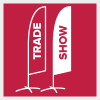 Trade shows
Trade shows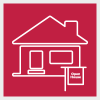 Open houses
Open houses Celebrations
Celebrations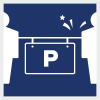 Parades
Parades Community events
Community events Grand openings
Grand openings Product launches
Product launches Public relations campaigns
Public relations campaigns
If you need a large-format medium that will be eye-catching either up close or from a distance, custom flags or banners would be a perfect choice. How you select its size, shape and material would depend on the intended purpose.
Selecting Custom Business Banners: Size and Type
Custom flags or banners do not need to be a “standard” rectangle. You can select any shape that best represents your business. There are some shapes that are commonly used to convey special meaning:
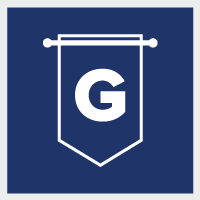

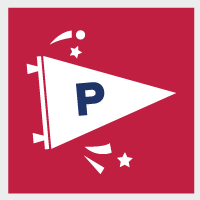
- Gonfalon – This five-point shape is often suspended from a crossbar, and is popular for schools and colleges. Therefore, it’s a great way to advertise back-to-school sales or promotions.
- Feather – The feather flag is tall and vertical, which makes it ideal for promotional purposes. You will often see several used at once in outdoor settings for complementary messages.
- Pennant – A pennant on its own can give the rah-rah feel of rallying for a sports team. They’re also used as a string along the outside of buildings or the periphery of parking lots for grand openings or other major events. A pennant string in your business’ color scheme could be a great investment to draw visual attention any time you are having a big sale or other promotional event.
Preparing Your Brand Standards

Once you’ve chosen your flag or banner shape and size, it’s time to determine how it will visually represent your business. As with any form of advertising, your brand logo or representation should be based on how you want the brand to be perceived by your target customer. If your logo will not be part of the custom flag or banner design, you should consider representing your brand through colors or typeface. As you consider your brand standards for a custom flag or banner, think about these factors:
- File type – A logo or artwork in vector is ideal, as it can be scaled without losing any detail. If not vector, your image should be at least 300 DPI in .psd, .tiff, or .jpg file format.
- Colors – The Pantone Matching System (PMS) is the most common color-matching system used to ensure print consistency. Tools like cal-print.com can help you identify the PMS colors used in your logo.
- Contrast and compatible colors – The dominant color in your logo can help identify compatible colors to use in the background or accompanying images on your flag or banner. A color calculator (you can find one here) can help you identify a few options.
- Typeface – Keep your text simple. If possible, limit your flag or banner to just your logo and a few words. Avoid curly or cursive script, which can be difficult to read from afar.
- Logo and image balance/visibility – Is your logo or your message the focal point of your design? For text visibility, the rule of thumb is a ratio of one inch of letter height per ten feet of distance (http://www.gawck.ca/large-format-typography-tips.html).
Why choose Gettysburg Flag Works?
In the first months of 2015, Gettysburg Flag Works has completed approximately 6,264 custom flag and banner orders. Let us help you choose the right type of flag and banner. We’ll guide you through what that flag can do for your business, and making sure it’s the best product it can possibly be.

These are some fantastic tips, I especially like that the article recommends creating the design for the flag as a vector. Vector graphics are much easier to scale up or down without running the risk of pixelating the image. This allows you to make any sized flag you want without risking it becoming illegible because you’ve stretched or compressed the image too far.